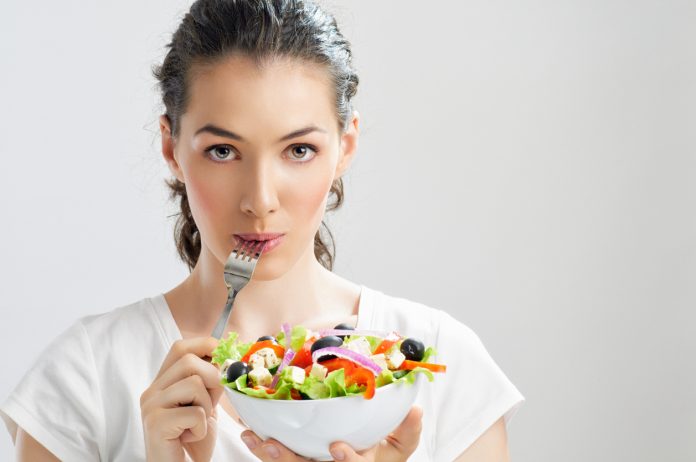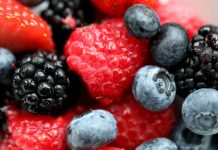The two biggest food groups are “potatoes, bread, rice, pasta, and other starchy carbohydrates” (yellow area) and “fruit and vegetables” (green section).
The updated guide features pictures of wholegrain cereal and brown spaghetti with bread, emphasizing the importance of including high-fiber foods in our diets.
This degree of information was absent from the previous version, which instead listed every kind of food that contains carbohydrates, including cornflakes and white spaghetti.
The next section, which has been re-named ‘beans, pulses, fish, eggs, meat and other protein’ has increased in size from 33% to 40%
It includes a far greater range of foods high in protein and places less focus on meat as the primary source of protein.
In the meanwhile, the blue section emphasizes selecting reduced fat and lower sugar options and offers advice about dairy foods.
It also contains substitutes for dairy, like soy milk.
This section has been reduced from 15% to 7%.
The purple section, which makes up just 1% of the healthy plate has been streamlined to contain just unsaturated oils, low fat oils and spreads due to the fact that
Because fats are heavy in calories, they should only be eaten occasionally.
Who can use the Eatwell Plate?
We may all utilize it to ensure that, on average, we consume the appropriate amount of both “good” and “bad” food.
You can apply the Eatwell Guide and yet be content with your weight, want to lose weight, consume meat, or adhere to a vegan or other diet.
It is also something that people of all ethnic backgrounds may follow.
However, if you happen to be following a special diet or are taking certain medication that may be impacted by your diet, then it’s best you speak to a dietician
regarding the safe ways to modify the Eatwell Guide to suit your individual requirements.
Though the Eatwell Plate is applicable to adults alone, children under the age of
This is due to the fact they have different nutritional needs from adults.Meanwhile, children over the age of 2 and up to 5 should gradually move to eat the same
the Eatwell Guide’s recommendations for meals as the rest of their family.
How do you make a Eat Well Plate?
This is what a healthy plate of food looks like, according to the Eatwell Guide:
38% of potatoes, bread, rice, pasta and other starchy carbohydrate foods.
40% of fruit and vegetables
8% of dairy food and alternatives
12% of beans, pulses, fish, eggs, meat and other protein
1% of oils and spreads
6 to 8 glasses of water, low-fat milk, or sugar-free beverages, such as tea and coffee, each day. 150ml of fruit juice or smoothies per day is the recommended daily intake.
Foods that contain fat, salt and sugar (e.g)
Chocolate, cakes, cookies, sugary soft drinks, butter, and ice cream are among the foods that should be consumed in moderation and in smaller amounts.
The Eatwell Guide is not only simple to use, but it can be applied to all of your food and drink selections, eliminating any doubt as to when and how to apply it.
It guides you toward making better, more thoughtful decisions whether you’re cooking, grocery shopping, dining out, or just grabbing some food on the run.
What is the pink section on the Eat Well Plate?
Beans, pulses, fish, eggs, meat, and other proteins are now included in the pink area that was previously labeled as “meat, fish, eggs, beans, and other non-dairy sources of protein.”
This adjustment is meant to encourage us to consume less red meat and processed meat, eat two portions of fish (at least one of which needs to be oily), and boost our intake of beans and pulses.
Alternative free-from foods are now much more readily available in supermarkets and other outlets due to a change in eating habits over the past several years.
Oat milk, lactose-free milk, and other dairy, egg, gluten-free, and meatless substitutes are a few examples.
What is the pink section on the Eat Well Plate?
Beans, pulses, fish, eggs, meat, and other proteins are now included in the pink area that was previously labeled as “meat, fish, eggs, beans, and other non-dairy sources of protein.”
This adjustment is meant to encourage us to consume less red meat and processed meat, eat two portions of fish (at least one of which needs to be oily), and boost our intake of beans and pulses.
Alternative free-from foods are now much more readily available in supermarkets and other outlets due to a change in eating habits over the past several years.
Oat milk, lactose-free milk, and other dairy, egg, gluten-free, and meatless substitutes are a few examples.
The updated Eat Well Plate is a tool designed to assist individuals in selecting the best foods. That’safe
A slight redesign of the Eatwell Plate has been made in recent years.
The Department of Health initially introduced it in the early 1990s to assist individuals in comprehending their guidelines for the composition of a nutritious and well-balanced diet.excellent
Back then, it was known as the Eatwell Plate, but following a relaunch is 2016, is now known as The Eatwell Guide.1
In addition to the name change, the plate has undergone a few minor adjustments to better convey the suggested foods and beverages and to account for updates.
in eating habits.This post by Amrit Kaur Khaneja, one of our nutritionists, goes over all there is to know about the Eatwell Plate, including what you should and shouldn’t eat as well as the history of its creation and updates.
What is the Eatwell Plate?
It functions as a kind of visual guide that indicates how much of each of the following five food types we should eat:
Fruit and vegetables
Bread, pasta, rice, potatoes, and other starchy carbs
Meat, fish, eggs, lentils, beans, and other sources of protein
Dairy and alternatives
Oil and spreads
The recommendation is based on a daily caloric intake of 2,500 for males and 2,000 for women (including food and drink).
Regarding the changes that have occurred since the healthy plate was reintroduced.
To make it even easier for people to choose the foods and beverages that they should ideally put in their bodies on a daily basis, the guidelines have been reviewed and improved in certain areas.
Consequently, all foods heavy in fat, salt, and sugar—like chocolate, chips, and sugary drinks—are no longer included in the Eatwell Guide’s primary plate image.
The updated edition also offers recommendations on hydration, such as limiting the amount of fruit juice and smoothies consumed and encouraging people to drink 6 to 8 cups or glasses of fluid each day.
The new guidance also includes the average calories per day that men and women should be aiming for.
What does the Eat Well Plate aim to achieve?
It’s designed to explain the proportion of the food we should consume from each food group to achieve a healthy balanced diet.
The guidelines are in line with what the government recommends for adults and kids who are older than five.
The Balance of Good Health, the UK’s national food guide, was first presented as a model to assist in defining government recommendations for the composition of a healthy, balanced diet.





























